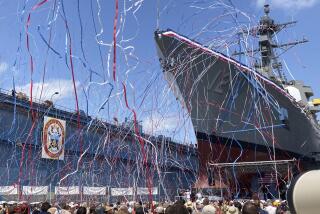Barry K. Atkins, 94; Admiral Won World War II Navy Cross for Valor
- Share via
Retired Adm. Barry K. Atkins, who received the Navy Cross for extraordinary heroism while commanding what many military historians believe was the only U.S. Navy destroyer to sink an enemy battleship during World War II, has died. He was 94.
Atkins died Tuesday of natural causes in a hospital in Richmond, Va., a family spokesman said.
A 1932 graduate of the U.S. Naval Academy in his hometown of Annapolis, Md., Atkins was commanding officer of the Melvin during the Battle of Leyte Gulf in the Philippines, widely regarded as the world’s largest sea battle.
About 3 a.m. on Oct. 25, 1944, as the Melvin and two other destroyers entered the narrow Surigao Strait, the Japanese battleship Fuso was spotted about 10,000 yards ahead.
Deviating from plan, Atkins brought his destroyer closer to the Fuso and at a better angle. He then ordered his crew to fire 10 torpedoes. Nine were launched and one misfired.
The Fuso, meanwhile, spotted the Melvin and began firing star shells, flares that illuminated the sky.
As Atkins recalled in a 2004 Associated Press interview, the Fuso “opened fire on us, and I didn’t care for that, particularly because they were getting pretty close to hitting us. I remember saying to the ship’s doctor, ‘When the heck are those torpedoes going to get there?’ ”
Atkins told the Richmond Times Dispatch in 2002 that he figured it would take about eight minutes for the torpedoes to travel 10,000 yards. But after eight minutes and no explosion, he thought he had fired too soon and from too far away.
But moments later, as he looked through his binoculars, he saw two or three flashes.
“In the analysis of the battle, there was some debate as to whether one or two torpedoes hit the Fuso,” he told the Times Dispatch. “My theory was that one torpedo hit the fuel tanks at midship, because the ship broke in half.”
After the Japanese battleship began engaging the Melvin, former crew member Dr. Edgar A. Hawk told the Associated Press recently, “the old man had thrown it on full rudder and we’re getting the heck out of there. He was zigzagging up a storm.”
Through the battle, Atkins remained calm.
“I told the bridge crew not to worry, they won’t hit us. But I had no reason to think they wouldn’t,” Atkins said in “The Last Epic Naval Battle, Voices From Leyte Gulf” by David Sears.
The Melvin and the two other destroyers, the McGowan and the Remey, fired 27 torpedoes, according to the recent Associated Press account. At the end of the three-day Battle of Leyte Gulf, Allied forces reported 3,500 dead to Japan’s 10,000, including virtually all 1,400 crewmen aboard the Fuso.
It took 14 years for the Navy to release a classified tactical analysis of the battle by the U.S. Naval War College, confirming the Melvin’s role in the sinking of the Fuso. The McGowan and the Remey also fired torpedoes at the Fuso but missed.
Last year, former Melvin crew members launched an effort to have a Navy ship named in honor of Atkins, who retired from the Navy in 1959 and was in an assisted-living facility in Richmond.
Former seaman Alex Parley, who is leading the effort, told the Associated Press that Atkins shied away when told what they were trying to do. “He said, ‘You can’t name a ship after a living person,” said Parley, who was told by the Navy that his nomination would receive “every consideration when names are chosen for future ships.”
Parley also was working to have the Naval War College Museum build a model of the Melvin as part of a display on the Battle of Leyte Gulf.
Atkins believed a tribute to his crew was long overdue.
“If the only way we’ll get any credit for what the Melvin did is to have a ship named after me, well then that’s OK by me,” he told the Associated Press last December.
Atkins is survived by his children, Sue-Sheila Strong Keener, Lynn Strong Agee, and Norman and Ian Atkins; four grandchildren; and three great-grandchildren.

